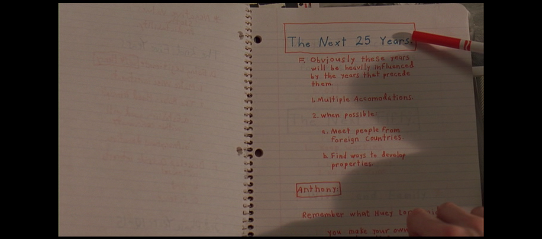
Reader / humorist / friend (titles in ascending order of importance) David Black wrote in recently and asked a very interesting question. He was wondering if the obtrusive hallmarks of a Wes Anderson film could also be serving as barriers, holding his films back from being great in their own right. In other words, does Anderson’s strict adherence to being Anderson restrict the growth of his films?
My first instinct, of course, is to respond with a simple no, hit David very hard with the Royal Tenenbaums script book, and never speak of it again. But he’s far away and I actually do think it’s a topic worthy of consideration. After all, Anderson’s films — like Anderson’s characters — do erect walls between themselves and others. It’s part of what defines their identities. Dignan plots every step of his life 75 years in advance, Steve Zissou surrounds himself with script writers, camera men and original score composers so that he’ll never have to cope with an unstructured moment, and Francis Whitman distributes daily itineraries — laminated, natch — to keep his brothers ever on task.
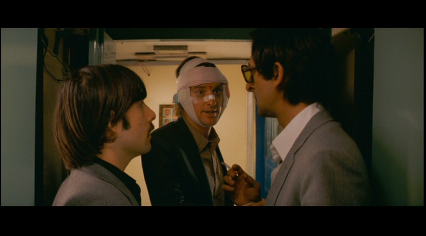 Those are his characters, of course, but in a larger sense Anderson does the same thing. His scenes are dense and detailed, his dialogue deliberate and cautiously delivered, and his soundtracks meticulous. There’s rarely a moment in any of his films that feels spontaneous; it would work against what he does, and it would be well outside of his comfort zone. The films of Wes Anderson are almost painfully composed. You may not feel that his scenes are particularly lively or energetic, but allow your eyes to drift a bit to the margins and you’re going to find evidence of truly passionate, boundless and insatiable creativity…a carefulness of purpose that seeps much deeper into every scene than the words his characters are asked to speak.
Those are his characters, of course, but in a larger sense Anderson does the same thing. His scenes are dense and detailed, his dialogue deliberate and cautiously delivered, and his soundtracks meticulous. There’s rarely a moment in any of his films that feels spontaneous; it would work against what he does, and it would be well outside of his comfort zone. The films of Wes Anderson are almost painfully composed. You may not feel that his scenes are particularly lively or energetic, but allow your eyes to drift a bit to the margins and you’re going to find evidence of truly passionate, boundless and insatiable creativity…a carefulness of purpose that seeps much deeper into every scene than the words his characters are asked to speak.
Which, I think, becomes quickly the crux of my response. The hallmarks to which Dave alludes are clear, and his question about their accidentally subverting Anderson’s emotional thrust is valid. After all, what are some of the most common criticisms about Anderson’s films? Read a negative review or ask somebody who’s not particularly a fan, and you’re bound to hear things like “unnatural dialogue,” “unrealistic characters,” “coldness.” Perhaps Anderson is missing the forest for the trees, so to speak, spending so much time and investing so much of his energy in refining the details that he forgets to — or neglects to, or is unable to — provide an engaging and resonating emotional experience.
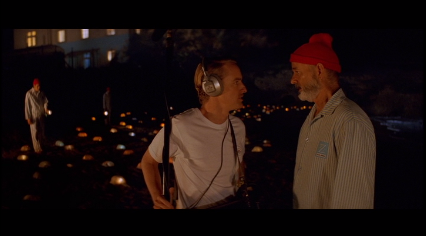 The question, as I say, is valid. The answer, however, relies on another question: is Anderson’s trademark detachment and ennui structurally consistent — or tonally sound — with whatever grander point he’s trying to make? Kurt Vonneget’s fourth rule of fiction writing is this: Every sentence must do one of two things–reveal character or advance the action. He was speaking about literature, but we can apply that to film as well, so long as we broaden our concept of the word “sentence.” And even though Vonnegut himself actively encouraged breaking these rules, it provides us with a decent baseline of intent: do each of Anderson’s details either reveal character or advance the action?
The question, as I say, is valid. The answer, however, relies on another question: is Anderson’s trademark detachment and ennui structurally consistent — or tonally sound — with whatever grander point he’s trying to make? Kurt Vonneget’s fourth rule of fiction writing is this: Every sentence must do one of two things–reveal character or advance the action. He was speaking about literature, but we can apply that to film as well, so long as we broaden our concept of the word “sentence.” And even though Vonnegut himself actively encouraged breaking these rules, it provides us with a decent baseline of intent: do each of Anderson’s details either reveal character or advance the action?
I would absolutely say yes, though Anderson’s intentions lean far more toward revealing character than advancing action. After all, in each of his films the seeming narrative thrust is subverted and replaced before it really gets moving, whether it’s Max getting expelled from The Rushmore Academy, Royal’s lie being exposed or the brothers Whitman being left behind by the titular train, Anderson is telling us in each case that the story is changing, all around us. We once meant to do this, but now, instead, we are going to do that. What happens isn’t important merely because it happened…it’s important because of how it made us feel. As the great Frank Zappa said, you should be digging it while it’s happening, because it just might be a one-shot deal.
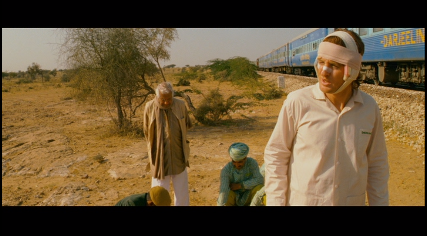 Advancing the action is of comparatively little interest to Anderson, and he’s perfectly willing to bring it to a complete stand-still if it means we’ll get to spend more time learning about his characters…something that happens quite literally in The Darjeeling Limited when the train comes to a complete stop, leaving the Whitmans (and us) with an unplanned opportunity for ceremony and soul searching.
Advancing the action is of comparatively little interest to Anderson, and he’s perfectly willing to bring it to a complete stand-still if it means we’ll get to spend more time learning about his characters…something that happens quite literally in The Darjeeling Limited when the train comes to a complete stop, leaving the Whitmans (and us) with an unplanned opportunity for ceremony and soul searching.
But what do Anderson’s obtrusive hallmarks — the reason Dave asked this question in the first place — have to do with this? Well, on the surface, perhaps not much. Anderson’s characters are as deliberately constructed and detailed as his sets, something even his detractors would admit, but these details can serve as deterrents to digging deeper, and finding a real human being inside. That’s something that some would call a weakness, but it’s exactly what Anderson wants. He may well overtly manufacture his characters, but since these characters overtly manufacture their lives, that’s a pretty fitting approach, thematically speaking. In fact, I think it’s much more helpful to view the question from the ground up: instead of looking at Anderson as a man creating these characters, look at the characters themselves, and then see Anderson’s methods as a way of telling their stories while remaining true to who they are.
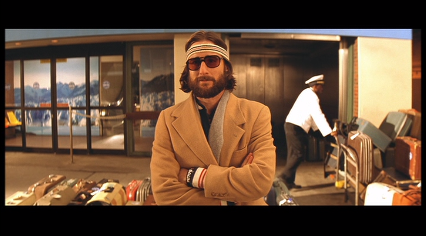 It’s difficult — and intimidating — to dig into Anderson’s characters in order to find a shred of humanity, but that’s not Anderson’s shortcoming; it is true the personas his characters deliberately cultivate. The most obvious example of this is Richie Tenenbaum, who isolates himself at sea, and behind sunglasses, and behind a curtain of hair, to prevent anybody from seeing who he really is. After his public meltdown he very much retreated from the world, and erected barricades to keep himself safe — if not exactly sane. When he finally lets down those walls, even in a solitary, dark bathroom, he sees the damaged and weak human being within, and he attempts to destroy it.
It’s difficult — and intimidating — to dig into Anderson’s characters in order to find a shred of humanity, but that’s not Anderson’s shortcoming; it is true the personas his characters deliberately cultivate. The most obvious example of this is Richie Tenenbaum, who isolates himself at sea, and behind sunglasses, and behind a curtain of hair, to prevent anybody from seeing who he really is. After his public meltdown he very much retreated from the world, and erected barricades to keep himself safe — if not exactly sane. When he finally lets down those walls, even in a solitary, dark bathroom, he sees the damaged and weak human being within, and he attempts to destroy it.
Richie’s attempted suicide is a self-fulfilling prophecy. He was afraid that if he let anybody inside, they would hurt him. Therefore the moment he lets himself inside, he knows what must be done.
In a less drastic sense, we can see deliberately cultivated quirk serving as emotional barricades for his siblings as well, which serves to underscore the fact that Anderson chooses these details carefully, rather than slopping them on for the sake of confounding audiences. In the case of Chas Tenenbaum, the matching red track suits that he wears with his two boys are a way of both pressing his sorrow inward — his wife’s death, which must be re-internalized every time he slips into the outfit — and sheltering himself and his family from ever facing it again, with the bright red uniforms becoming, suddenly, identifiable beacons in the event of tragedy.
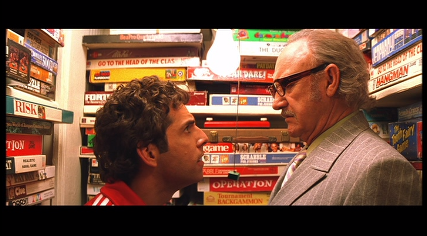 It’s an unspoken detail strengthened by the fact that the closest thing to a real tragedy — a car accident that kills his dog and nearly his sons — occurs once the track suits are removed. Its removal also, however, allows Chas to soak in the full benefit of a Zen garden, and without his protective shell he’s much more receptive to his father’s unexpectedly selfless gesture: buying the family a new dog. Being freed of this physical trapping allows Chas to admit to the true depths of his sorrow, something he was never able to do earlier, opting instead to storm off and internalize.
It’s an unspoken detail strengthened by the fact that the closest thing to a real tragedy — a car accident that kills his dog and nearly his sons — occurs once the track suits are removed. Its removal also, however, allows Chas to soak in the full benefit of a Zen garden, and without his protective shell he’s much more receptive to his father’s unexpectedly selfless gesture: buying the family a new dog. Being freed of this physical trapping allows Chas to admit to the true depths of his sorrow, something he was never able to do earlier, opting instead to storm off and internalize.
A similar — though differently functional — affectation can be seen in the case of Margot Tenenbaum, who — for reasons equally unspoken — chooses to wear a wooden replacement for her missing finger, both visually and aurally obtrusive, rather than something a bit less conspicuous. To many, this might seem like just one more of Wes Anderson’s distracting details that allow him to focus on design over character development, but for Margot it’s a symbol of her own detachment. She wears it like a scar, and draws attention to it so it won’t be forgotten.
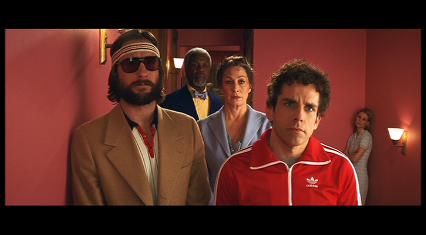 Throughout the film she stands apart from the rest of her family, likely a result of Royal’s tendency to inform people up front that she’s adopted, and therefore not technically his. This unwitting familial detachment became a defining feature of her personality, and ultimately manifested itself physically during a visit to her biological family, where her finger is accidentally severed, and her outfit and demeanor make clear that she’s necessarily detached from that family as well. Her missing finger is a symptom, and a reminder of a completeness she will never feel.
Throughout the film she stands apart from the rest of her family, likely a result of Royal’s tendency to inform people up front that she’s adopted, and therefore not technically his. This unwitting familial detachment became a defining feature of her personality, and ultimately manifested itself physically during a visit to her biological family, where her finger is accidentally severed, and her outfit and demeanor make clear that she’s necessarily detached from that family as well. Her missing finger is a symptom, and a reminder of a completeness she will never feel.
I think that instead of Anderson’s hallmarks standing as obstructions to genuine greatness, they instead help inform a cohesive whole. His films work better with a cumulative impact, meaning more and reaching deeper the more of them you experience. One film on its own may or may not move you, but viewing several will give you a better opportunity to feel moved by his uncommon methods. And like the unreliable narrators of Nabokov or the deliberately terrifying specificity of Pynchon, these are similar devices deployed differently each time, seeming similar when viewed from a distance but, once studied, revealing themselves to be impressive variations upon what we may have thought was a barren theme.
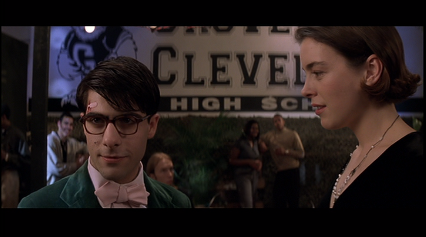 Consider, for instance, Max Fischer in Rushmore. Max also lives an affected life, with a deliberate bearing and an impressive attention to detail. But this is a life he has manufactured in order to detract from what’s actually there: he is a barber’s son. He piles on extracurricular activities to distract from his less impressive curricular performance. He creates art, wills companionship and outright lies about his father’s vocation and sexual exploits, all in the service reinforcing a bubble around himself, constructing a world that means everything to him that he wished the world could mean on its own. He even demands control over his soundtrack, bringing a cued-up cassette tape along when he makes his move on Miss Cross, and signaling to a disc-jockey to play Ooh La La as an indication of the progress he’s made…even as such a gesture tends to call that very progress into question.
Consider, for instance, Max Fischer in Rushmore. Max also lives an affected life, with a deliberate bearing and an impressive attention to detail. But this is a life he has manufactured in order to detract from what’s actually there: he is a barber’s son. He piles on extracurricular activities to distract from his less impressive curricular performance. He creates art, wills companionship and outright lies about his father’s vocation and sexual exploits, all in the service reinforcing a bubble around himself, constructing a world that means everything to him that he wished the world could mean on its own. He even demands control over his soundtrack, bringing a cued-up cassette tape along when he makes his move on Miss Cross, and signaling to a disc-jockey to play Ooh La La as an indication of the progress he’s made…even as such a gesture tends to call that very progress into question.
(As an amusing sidenote, Jason Schwartzman’s character in The Darjeeling Limited shares this compulsive control over his life’s soundtrack, relying on his iPod in the same way that his brother relies on his laminating machine to keep the universe in order.)
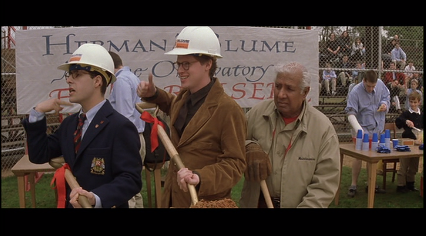 All of which leads me to believe even more strongly that Anderson’s hallmarks are not just hallmarks, but appropriate showcases for his characters, and respectful echoes of who they wish to be. Rushmore itself is structured like a play, with act breaks and a curtain call, a framing device that draws even greater attention to Max’s careful manipulation of the world around him. He constructs literal scenes on stage, but sees the world around him with a similar directorial eye. Anderson’s shots and soundtrack may have been carefully chosen, but it’s pretty fair to say that he is being true to Max, who would have chosen the same ones. Had Bert Fischer been the central character, we would instead have seen a diminished level of attention, a softer and more optimistic viewpoint, and — if the music in his barber shop is any indication — a soundtrack of cool and unobtrusive jazz.
All of which leads me to believe even more strongly that Anderson’s hallmarks are not just hallmarks, but appropriate showcases for his characters, and respectful echoes of who they wish to be. Rushmore itself is structured like a play, with act breaks and a curtain call, a framing device that draws even greater attention to Max’s careful manipulation of the world around him. He constructs literal scenes on stage, but sees the world around him with a similar directorial eye. Anderson’s shots and soundtrack may have been carefully chosen, but it’s pretty fair to say that he is being true to Max, who would have chosen the same ones. Had Bert Fischer been the central character, we would instead have seen a diminished level of attention, a softer and more optimistic viewpoint, and — if the music in his barber shop is any indication — a soundtrack of cool and unobtrusive jazz.
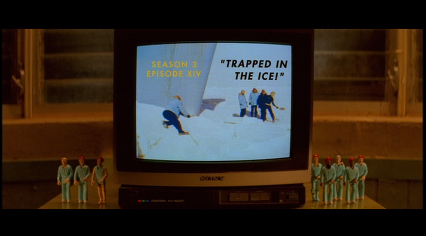 It’s clear, I think, that Anderson’s characters need this sort of careful composition if they can ever feel at home, and he chooses locations that are conducive to such isolated structuring, whether it’s The Rushmore Academy, 111 Archer Ave. or the Belafonte research vessel. These are the worlds Anderson has created, yes, but they’re also the worlds his characters have created, plying their own layers of history and detail into every room and onto every shelf, whether it’s a massive collection of board games in the closet or a set of out-of-production action figures flanking the television, some method of keeping reality at bay…some protection against a harsh world that has already moved on, and continues to move on, without you.
It’s clear, I think, that Anderson’s characters need this sort of careful composition if they can ever feel at home, and he chooses locations that are conducive to such isolated structuring, whether it’s The Rushmore Academy, 111 Archer Ave. or the Belafonte research vessel. These are the worlds Anderson has created, yes, but they’re also the worlds his characters have created, plying their own layers of history and detail into every room and onto every shelf, whether it’s a massive collection of board games in the closet or a set of out-of-production action figures flanking the television, some method of keeping reality at bay…some protection against a harsh world that has already moved on, and continues to move on, without you.
I don’t think Anderson’s hallmarks serve as barricades, and they won’t as long as he continues to find new ways to apply them, and interesting directions with which he might explore his themes. I think they instead spotlight the self-inflicted trappings of his main characters, and the walls within which they remain their own prisoners. Anderson simply revels in exploring the smallness of the worlds around his characters, and mapping the boundaries that hem them in.
As an artist, he’s revealing character…albeit in an off-putting, defensive, oblique way. And what better way to be true to characters that work so hard to do the same?
2 thoughts on “Reader Mail: Art From Artifice”
Comments are closed.